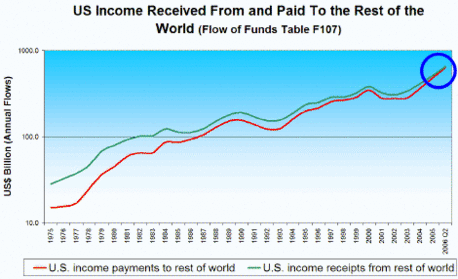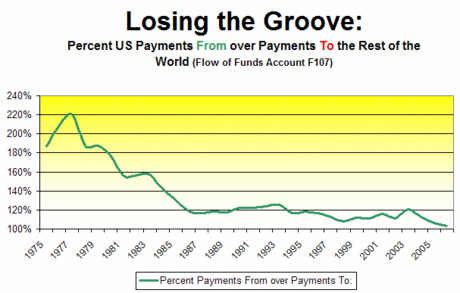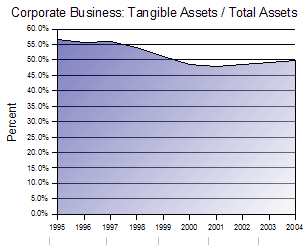Signs of US Losing Its Groove in International Markets?
by John Schroy filed under Corporate Managers, Foreign Investors
Federal Reserve flow of funds table F107 (Rest of the World) for Q2 2006 shows that the flow of US income from other countries increased by 202% compared to flows in the year 2001. The increase in inflows in the few years since 2001 amounted to US$331.6 billion.
Does this mean that all is rosy in the economy?
The graph shows the dramatic increase in US income from abroad since 1975.
The graph also shows that income from the US paid to the rest of the world has been growing at and even faster rate and the excess of income from abroad is about to disappear.
 The gap Between Income To and From the Rest of the World is being pinched off
|
||
How the US Lost Its Groove
Thirty years ago, about the time the world went off the gold standard, US income from abroad was more that double the amount of income that the US paid to the Rest of the World.
The massive foreign investments made by US companies in developing markets abroad in the 1950s and 1960s, paid handsome dividends. The government at the time saw US investment in foreign countries as an essential element in the Cold War — spreading the ‘American message’ of free enterprise as an alternative to communism.
However, by the 1970s, as Baby Boomers entered middle management and asset-lite policies began to sway corporate boards, interest in building overseas plants began to give way to ’supply-chain management’ and ‘just-in-time’ inventory controls.
Meanwhile, foreign industries were taking advantage of the US lack of concern regarding the trade deficit. Imports from abroad began to exceed US exports at an ever-increasing rate.
This ‘trade deficit’, denominated mainly in US dollars, was invested in US securities, mainly bonds that paid interest that was reinvested and compounded.
Within a year or so, it seems inevitable that the amount of income that the US pays to the rest of the world will surpass the amount that US investors earn abroad.
 The US Income Surplus with the Rest of the World is about to disappear
|
||
Although it would appear that the US has ‘lost its groove’ in its ability to earn more abroad than it pays out, does this really matter? Does anyone care?
Since income payments are mostly in US dollars (rather than a foreign currency), the ‘income deficit’ is no more threatening to economic stability than the ‘trade deficit’;
The amount of US income earned abroad has increased 23 times since 1975, from only $28 billion to $654 billion — an indication of the triumph of globalization;
The amount of US income paid abroad in Q2 2006 was 6.6% of disposable household income . This indicates the degree to which the US economy is dependent upon globalization.
US income paid abroad in Q2 2005 was 58% of US corporate profits before tax! This is indicative of the decline of US corporations as a result of ‘asset-lite’ management and the diversion of corporate funds through the buyback movement.
With regards to the latter point, I would refer to the article, “Corporate Executives Pocket Billions from the Jobs Creation Act“, which suggests US corporate attitudes regarding long-term investment in American companies.
In any event, we might reasonably expect US income paid abroad to begin to surpass income earned from the Rest of the World any day now.



